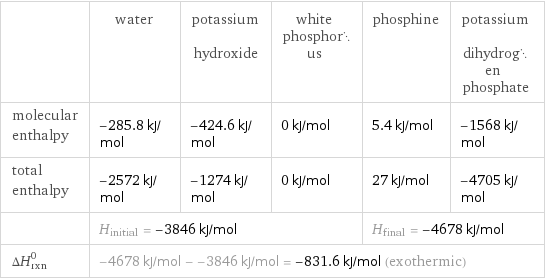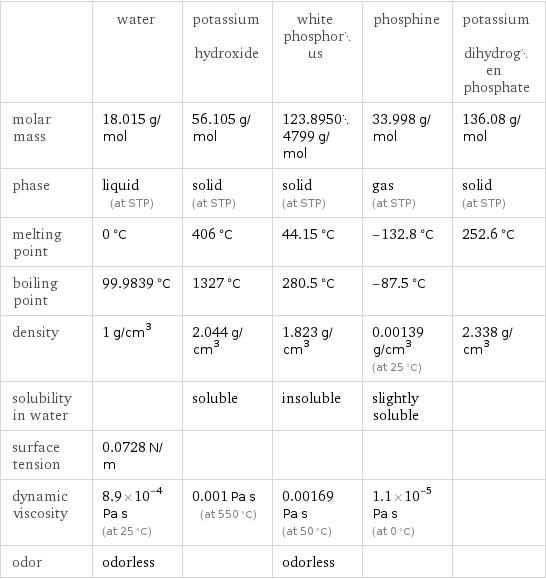Input interpretation

H_2O water + KOH potassium hydroxide + P_4 white phosphorus ⟶ PH_3 phosphine + KH_2PO_4 potassium dihydrogen phosphate
Balanced equation

Balance the chemical equation algebraically: H_2O + KOH + P_4 ⟶ PH_3 + KH_2PO_4 Add stoichiometric coefficients, c_i, to the reactants and products: c_1 H_2O + c_2 KOH + c_3 P_4 ⟶ c_4 PH_3 + c_5 KH_2PO_4 Set the number of atoms in the reactants equal to the number of atoms in the products for H, O, K and P: H: | 2 c_1 + c_2 = 3 c_4 + 2 c_5 O: | c_1 + c_2 = 4 c_5 K: | c_2 = c_5 P: | 4 c_3 = c_4 + c_5 Since the coefficients are relative quantities and underdetermined, choose a coefficient to set arbitrarily. To keep the coefficients small, the arbitrary value is ordinarily one. For instance, set c_3 = 1 and solve the system of equations for the remaining coefficients: c_1 = 9/2 c_2 = 3/2 c_3 = 1 c_4 = 5/2 c_5 = 3/2 Multiply by the least common denominator, 2, to eliminate fractional coefficients: c_1 = 9 c_2 = 3 c_3 = 2 c_4 = 5 c_5 = 3 Substitute the coefficients into the chemical reaction to obtain the balanced equation: Answer: | | 9 H_2O + 3 KOH + 2 P_4 ⟶ 5 PH_3 + 3 KH_2PO_4
Structures

+ + ⟶ +
Names

water + potassium hydroxide + white phosphorus ⟶ phosphine + potassium dihydrogen phosphate
Reaction thermodynamics
Enthalpy

| water | potassium hydroxide | white phosphorus | phosphine | potassium dihydrogen phosphate molecular enthalpy | -285.8 kJ/mol | -424.6 kJ/mol | 0 kJ/mol | 5.4 kJ/mol | -1568 kJ/mol total enthalpy | -2572 kJ/mol | -1274 kJ/mol | 0 kJ/mol | 27 kJ/mol | -4705 kJ/mol | H_initial = -3846 kJ/mol | | | H_final = -4678 kJ/mol | ΔH_rxn^0 | -4678 kJ/mol - -3846 kJ/mol = -831.6 kJ/mol (exothermic) | | | |
Equilibrium constant
![Construct the equilibrium constant, K, expression for: H_2O + KOH + P_4 ⟶ PH_3 + KH_2PO_4 Plan: • Balance the chemical equation. • Determine the stoichiometric numbers. • Assemble the activity expression for each chemical species. • Use the activity expressions to build the equilibrium constant expression. Write the balanced chemical equation: 9 H_2O + 3 KOH + 2 P_4 ⟶ 5 PH_3 + 3 KH_2PO_4 Assign stoichiometric numbers, ν_i, using the stoichiometric coefficients, c_i, from the balanced chemical equation in the following manner: ν_i = -c_i for reactants and ν_i = c_i for products: chemical species | c_i | ν_i H_2O | 9 | -9 KOH | 3 | -3 P_4 | 2 | -2 PH_3 | 5 | 5 KH_2PO_4 | 3 | 3 Assemble the activity expressions accounting for the state of matter and ν_i: chemical species | c_i | ν_i | activity expression H_2O | 9 | -9 | ([H2O])^(-9) KOH | 3 | -3 | ([KOH])^(-3) P_4 | 2 | -2 | ([P4])^(-2) PH_3 | 5 | 5 | ([PH3])^5 KH_2PO_4 | 3 | 3 | ([KH2PO4])^3 The equilibrium constant symbol in the concentration basis is: K_c Mulitply the activity expressions to arrive at the K_c expression: Answer: | | K_c = ([H2O])^(-9) ([KOH])^(-3) ([P4])^(-2) ([PH3])^5 ([KH2PO4])^3 = (([PH3])^5 ([KH2PO4])^3)/(([H2O])^9 ([KOH])^3 ([P4])^2)](../image_source/e9a463da902c5fc665957af8ba03a0aa.png)
Construct the equilibrium constant, K, expression for: H_2O + KOH + P_4 ⟶ PH_3 + KH_2PO_4 Plan: • Balance the chemical equation. • Determine the stoichiometric numbers. • Assemble the activity expression for each chemical species. • Use the activity expressions to build the equilibrium constant expression. Write the balanced chemical equation: 9 H_2O + 3 KOH + 2 P_4 ⟶ 5 PH_3 + 3 KH_2PO_4 Assign stoichiometric numbers, ν_i, using the stoichiometric coefficients, c_i, from the balanced chemical equation in the following manner: ν_i = -c_i for reactants and ν_i = c_i for products: chemical species | c_i | ν_i H_2O | 9 | -9 KOH | 3 | -3 P_4 | 2 | -2 PH_3 | 5 | 5 KH_2PO_4 | 3 | 3 Assemble the activity expressions accounting for the state of matter and ν_i: chemical species | c_i | ν_i | activity expression H_2O | 9 | -9 | ([H2O])^(-9) KOH | 3 | -3 | ([KOH])^(-3) P_4 | 2 | -2 | ([P4])^(-2) PH_3 | 5 | 5 | ([PH3])^5 KH_2PO_4 | 3 | 3 | ([KH2PO4])^3 The equilibrium constant symbol in the concentration basis is: K_c Mulitply the activity expressions to arrive at the K_c expression: Answer: | | K_c = ([H2O])^(-9) ([KOH])^(-3) ([P4])^(-2) ([PH3])^5 ([KH2PO4])^3 = (([PH3])^5 ([KH2PO4])^3)/(([H2O])^9 ([KOH])^3 ([P4])^2)
Rate of reaction
![Construct the rate of reaction expression for: H_2O + KOH + P_4 ⟶ PH_3 + KH_2PO_4 Plan: • Balance the chemical equation. • Determine the stoichiometric numbers. • Assemble the rate term for each chemical species. • Write the rate of reaction expression. Write the balanced chemical equation: 9 H_2O + 3 KOH + 2 P_4 ⟶ 5 PH_3 + 3 KH_2PO_4 Assign stoichiometric numbers, ν_i, using the stoichiometric coefficients, c_i, from the balanced chemical equation in the following manner: ν_i = -c_i for reactants and ν_i = c_i for products: chemical species | c_i | ν_i H_2O | 9 | -9 KOH | 3 | -3 P_4 | 2 | -2 PH_3 | 5 | 5 KH_2PO_4 | 3 | 3 The rate term for each chemical species, B_i, is 1/ν_i(Δ[B_i])/(Δt) where [B_i] is the amount concentration and t is time: chemical species | c_i | ν_i | rate term H_2O | 9 | -9 | -1/9 (Δ[H2O])/(Δt) KOH | 3 | -3 | -1/3 (Δ[KOH])/(Δt) P_4 | 2 | -2 | -1/2 (Δ[P4])/(Δt) PH_3 | 5 | 5 | 1/5 (Δ[PH3])/(Δt) KH_2PO_4 | 3 | 3 | 1/3 (Δ[KH2PO4])/(Δt) (for infinitesimal rate of change, replace Δ with d) Set the rate terms equal to each other to arrive at the rate expression: Answer: | | rate = -1/9 (Δ[H2O])/(Δt) = -1/3 (Δ[KOH])/(Δt) = -1/2 (Δ[P4])/(Δt) = 1/5 (Δ[PH3])/(Δt) = 1/3 (Δ[KH2PO4])/(Δt) (assuming constant volume and no accumulation of intermediates or side products)](../image_source/bc76a43e302e84655f5c8eb00c0e3606.png)
Construct the rate of reaction expression for: H_2O + KOH + P_4 ⟶ PH_3 + KH_2PO_4 Plan: • Balance the chemical equation. • Determine the stoichiometric numbers. • Assemble the rate term for each chemical species. • Write the rate of reaction expression. Write the balanced chemical equation: 9 H_2O + 3 KOH + 2 P_4 ⟶ 5 PH_3 + 3 KH_2PO_4 Assign stoichiometric numbers, ν_i, using the stoichiometric coefficients, c_i, from the balanced chemical equation in the following manner: ν_i = -c_i for reactants and ν_i = c_i for products: chemical species | c_i | ν_i H_2O | 9 | -9 KOH | 3 | -3 P_4 | 2 | -2 PH_3 | 5 | 5 KH_2PO_4 | 3 | 3 The rate term for each chemical species, B_i, is 1/ν_i(Δ[B_i])/(Δt) where [B_i] is the amount concentration and t is time: chemical species | c_i | ν_i | rate term H_2O | 9 | -9 | -1/9 (Δ[H2O])/(Δt) KOH | 3 | -3 | -1/3 (Δ[KOH])/(Δt) P_4 | 2 | -2 | -1/2 (Δ[P4])/(Δt) PH_3 | 5 | 5 | 1/5 (Δ[PH3])/(Δt) KH_2PO_4 | 3 | 3 | 1/3 (Δ[KH2PO4])/(Δt) (for infinitesimal rate of change, replace Δ with d) Set the rate terms equal to each other to arrive at the rate expression: Answer: | | rate = -1/9 (Δ[H2O])/(Δt) = -1/3 (Δ[KOH])/(Δt) = -1/2 (Δ[P4])/(Δt) = 1/5 (Δ[PH3])/(Δt) = 1/3 (Δ[KH2PO4])/(Δt) (assuming constant volume and no accumulation of intermediates or side products)
Chemical names and formulas

| water | potassium hydroxide | white phosphorus | phosphine | potassium dihydrogen phosphate formula | H_2O | KOH | P_4 | PH_3 | KH_2PO_4 Hill formula | H_2O | HKO | P_4 | H_3P | H_2KO_4P name | water | potassium hydroxide | white phosphorus | phosphine | potassium dihydrogen phosphate IUPAC name | water | potassium hydroxide | tetraphosphorus | phosphine | potassium dihydrogen phosphate
Substance properties

| water | potassium hydroxide | white phosphorus | phosphine | potassium dihydrogen phosphate molar mass | 18.015 g/mol | 56.105 g/mol | 123.89504799 g/mol | 33.998 g/mol | 136.08 g/mol phase | liquid (at STP) | solid (at STP) | solid (at STP) | gas (at STP) | solid (at STP) melting point | 0 °C | 406 °C | 44.15 °C | -132.8 °C | 252.6 °C boiling point | 99.9839 °C | 1327 °C | 280.5 °C | -87.5 °C | density | 1 g/cm^3 | 2.044 g/cm^3 | 1.823 g/cm^3 | 0.00139 g/cm^3 (at 25 °C) | 2.338 g/cm^3 solubility in water | | soluble | insoluble | slightly soluble | surface tension | 0.0728 N/m | | | | dynamic viscosity | 8.9×10^-4 Pa s (at 25 °C) | 0.001 Pa s (at 550 °C) | 0.00169 Pa s (at 50 °C) | 1.1×10^-5 Pa s (at 0 °C) | odor | odorless | | odorless | |
Units
